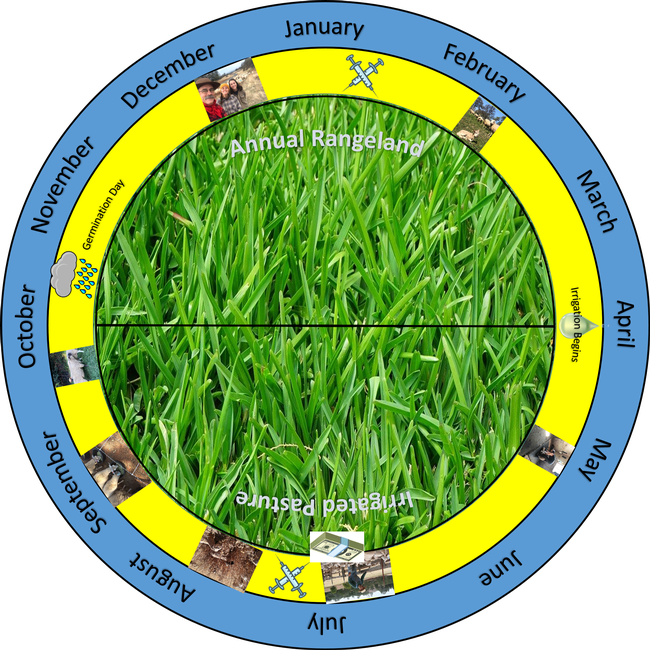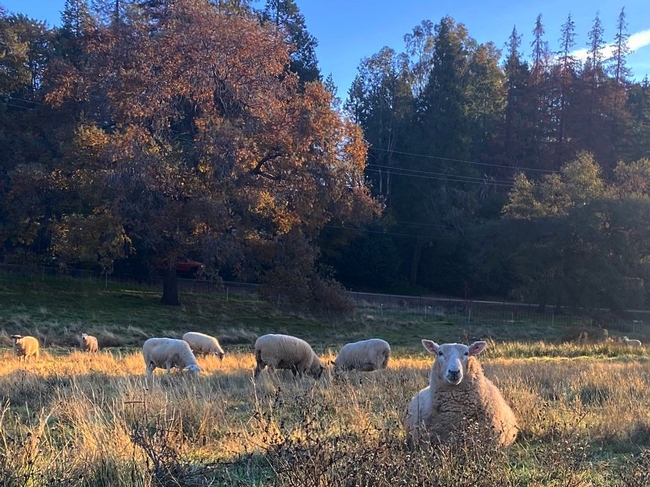Over the last ten years or so, I've had the opportunity to help teach farm and ranch business planning courses (first, as a collaborating producer; more recently, as an extension advisor). One of the exercises we've used to help producers relate their cash flow budgets to their production calendars is to create an operational timeline that includes key management activities - as well as the associated inflows and outflows of cash. While this timeline has been a useful teaching tool - it always seemed a bit flawed to me. The work of ranching, after all, is cyclical rather than linear. During our most recent Beginning Farming Academy, I tried a new approach - a circular calendar rather than a timeline. And it so happens that a recent article in Rangelands (the non-technical journal published by the Society for Range Management) puts a name to this approach. Karim-Aly Kassam, of the Department of Natural Resources and the Environment and the American Indian and Indigenous Studies Program at Cornell University, calls these "ecological calendars" - calendars that provide a systematic way to measure and give meaning to time based on our observations of the habitats in which we live.
As I read this paper, I realized that my approach to raising sheep largely revolves around this idea of an ecological calendar. Our sheep year starts and ends with the forage cycle here in the Sierra foothills. My starting point is to match our period of greatest nutritional demand (late gestation and early lactation - lambing season, in other words) with the time period when Mother Nature provides the greatest quantity of highly nutritious forage (the "spring flush"). This decision point gives us the ability to adjust our stocking rate to seasonal changes in the carrying capacity of our rangeland and irrigated pastures. We wean the lambs as the annual rangeland forages dry out. We manage our irrigated pasture to be sure we have quality forage prior to and during breeding season. Our ewes have their lowest nutritional demand during the late fall months. In many ways, our approach reflects an emphasis on the productivity of the ewes rather than the weaning weights of individual lambs - we're optimizing our ewes' ability to turn forage into fiber and lambs.
Our decision about when to lamb sets up other key dates in our production system, as well. We shear the ewes when the youngest lambs are 4-6 weeks old - in early May. The ewes shear better then, and we avoid some of the stickers that can contaminate our wool. We dry the ewes off (wean the lambs and end the ewes' lactation) on dry forage in mid-Summer - which allows us to rent the ewes out for fuel-load reduction on unirrigated rangeland. We flush the ewes (prepare them for breeding) in September, when our irrigated pasture begins to recover from the heat-induced summer slump in productivity. We turn the rams in with the ewes in late September, and the entire cycle starts again!
But as I've thought about our approach through the lens of an ecological calendar, I've realized that the key dates in our system have nothing to do with the chronological date - and everything to do with the annual cycles of weather and forage production. Rather than the names of the months, the headers on my ecological calendar are events - Germination Day, the Onset of Rapid Growth, the Summer Slump, the Autumn Rebound. Unlike the rigidity of the Gregorian calendar that most of us use, this ecological approach to our production schedule is incredibly flexible! Weaning day happens when the grass dries out, for example - which could be late May or late June, depending on the year. Longer-term flexibility is also possible - if we begin to see that our moisture and temperature regimes in the late winter and early spring change the timing of the spring flush, we can adjust our lambing date (by adjusting the date on which we turn the rams in with the ewes).
I suppose some will say that we're simply ranching with nature - that we're just adjusting our production to the cycles around us. But giving meaning to time based on my own observations of the world around me seems deeper than simply picking a lambing date to coincide with spring growth. Keeping track of how the world around me changes in response to things like the timing and amount of rainfall, the temperature of the air and the soil, the humidity and wind here in the foothills - all of this helps me adjust my interactions with the natural world. All of this helps make adapting our sheep enterprise to ever-changing conditions easier!

